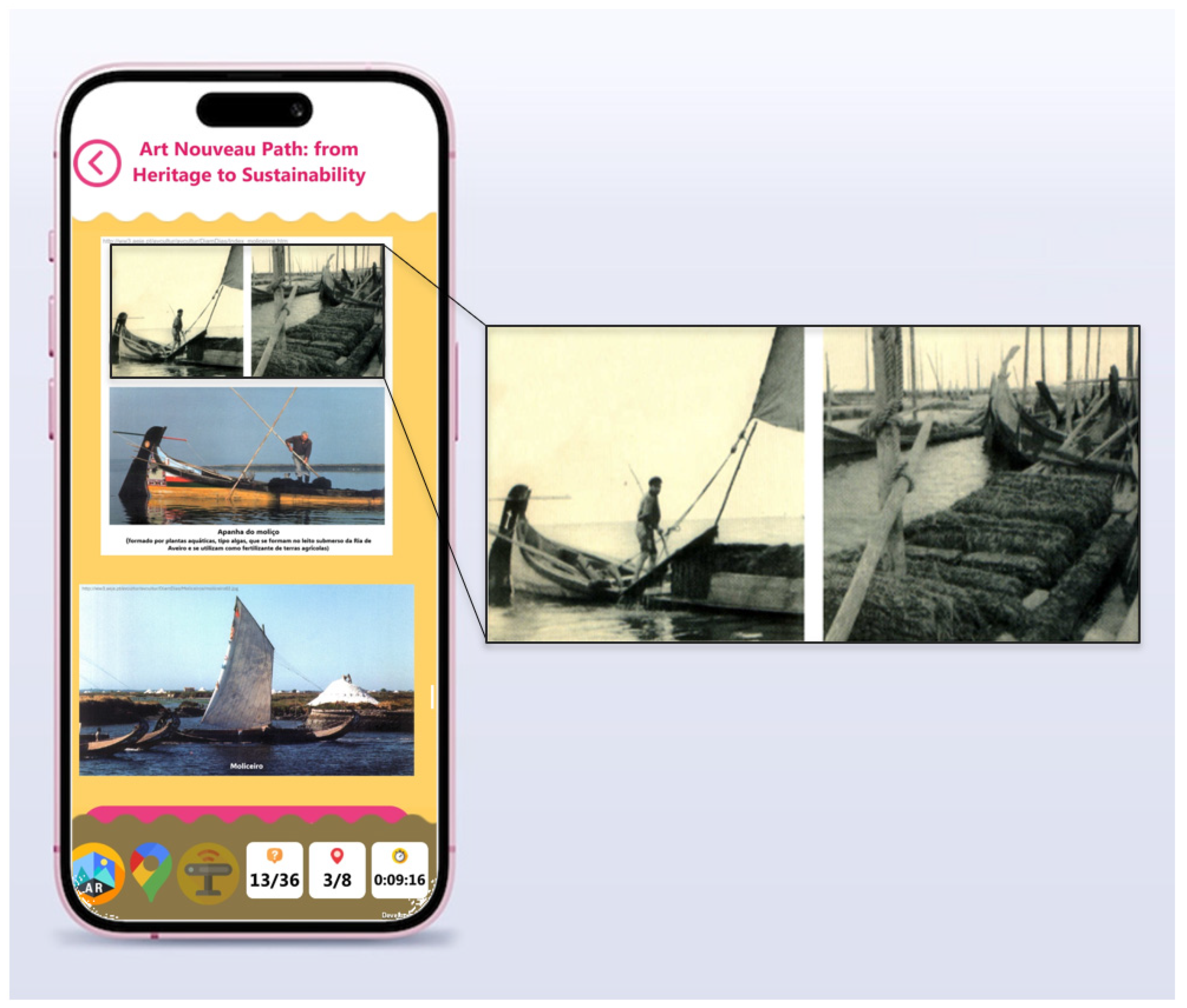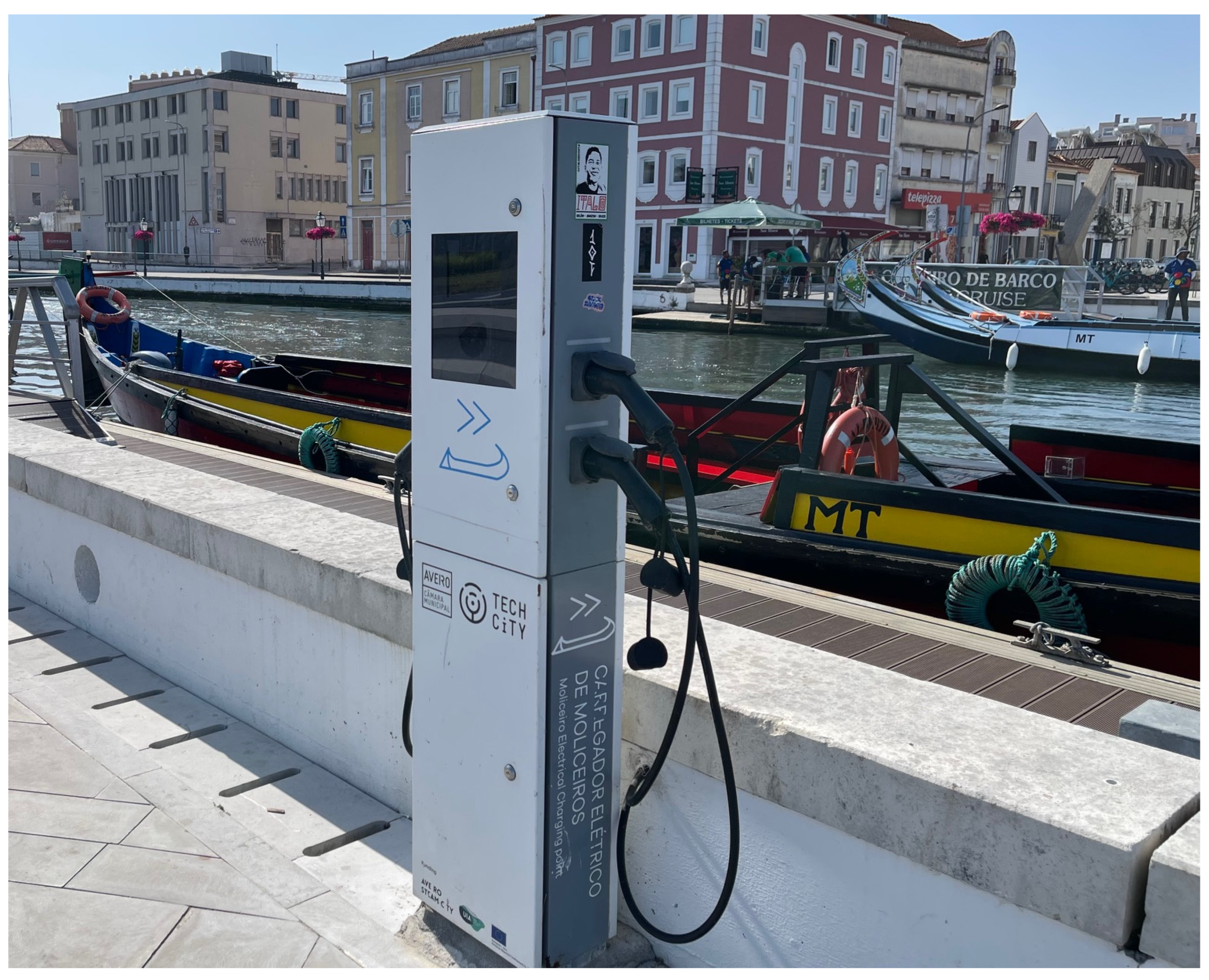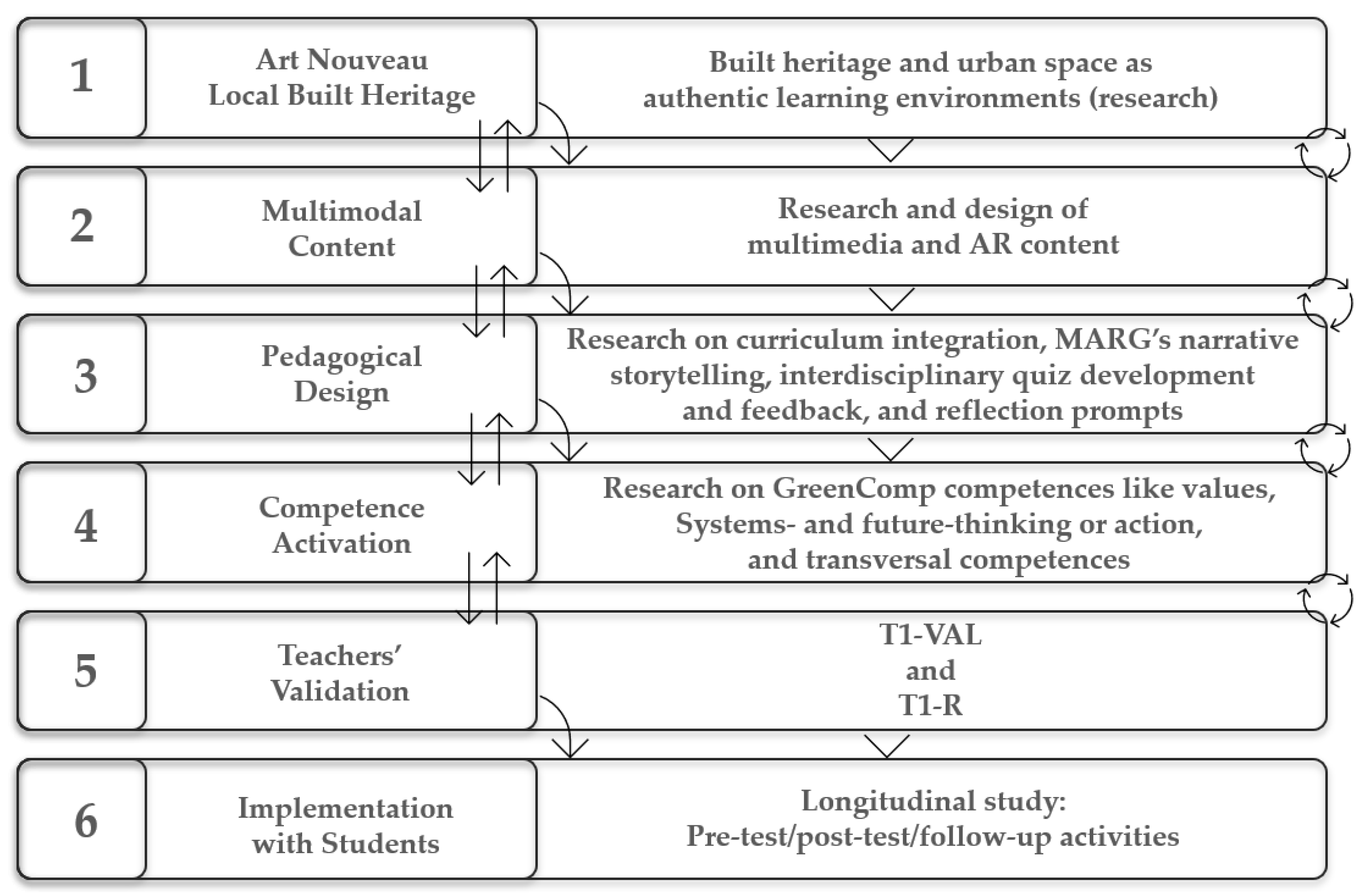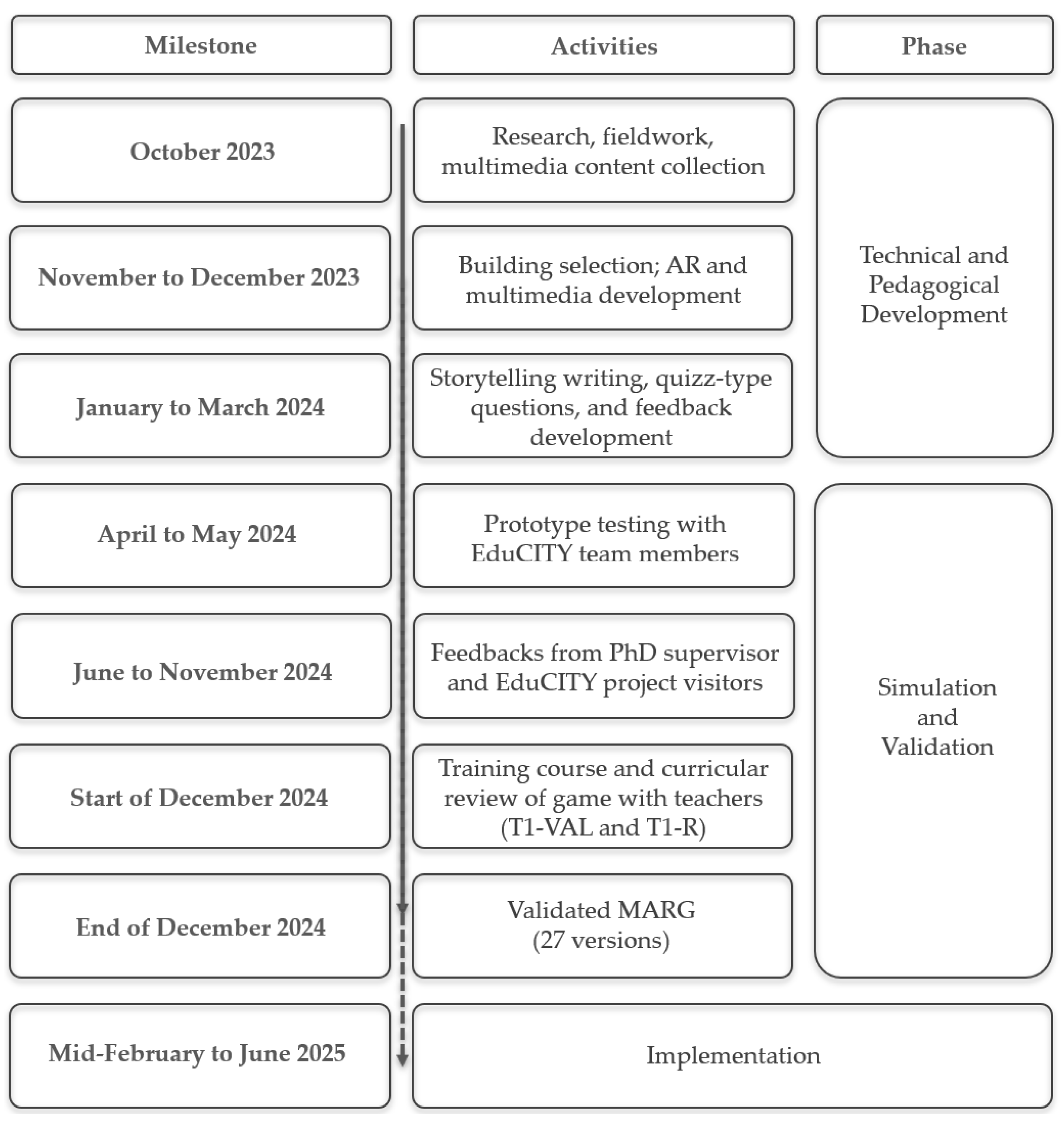The Art Nouveau Path: Promoting Sustainability Competences Through a Mobile Augmented Reality Game
Abstract
1. Introduction
- How do multimodal and location-based interactions within the Art Nouveau Path MARG influence learner engagement and the player experience?
- How can the MARG support the development of sustainability competences through context-aware educational interactions?
2. Theoretical Framework and Related Work
2.1. Multimodal and Context-Based Learning Through Mobile Augmented Reality
2.2. Operationalizing GreenComp in Context-Aware Heritage Education
2.3. Heritage as a Living Space for Sustainability Learning
2.4. Validating the Art Nouveau Path as a Sustainability-Focused Serious Game
| Study | Audience | Validation Strategy | Educational Focus | Competence Framework | N | Notes |
|---|---|---|---|---|---|---|
| Bekas & Xinogalos [45] | Students (aged 10–14) | Pre/post-test, SUS, interview | Ancient Greek history | Not specified | 129 | Escape room and trivia AR game |
| Chiang et al. [18] | University students | Comparison (on-site vs. off-site), t-tests | Cultural heritage of Taiwan | Not specified | 104 | Compared learning motivation and satisfaction in two settings |
| Kleftodimos et al. [19] | K–12 students | Survey (challenge, reuse, interaction) and SEM | Local heritage and sustainability | Not specified | 309 | Validated challenge and reuse dimensions |
| This study (T1-VAL, T1-R) | Teachers | Simulation (T1-VAL), teachers’ curricular review (T1-R) | Sustainability + heritage | GreenComp | 33 | Validated with teachers; implemented with more than 400 students (data not analyzed in this paper) |
- Local Built Heritage: based on the historical urban environment of Aveiro, which provides the real-world setting for the game.
- Digital Content: includes AR markers, multimodal multimedia, and interactive elements that connect players to space through technology.
- Pedagogical Design: features narrative tasks, reflection prompts, and interdisciplinary challenges to guide learning.
- Competence Activation: engages players in applying GreenComp-based KSA to real sustainability issues.
- Validation: informed by teacher feedback.
- Implementation: application of the final version of the game in an authentic educational setting.
3. Materials and Methods
3.1. Research Design and Methodological Alignment
3.2. Summary of Art Nouveau Path Context and Development
- Narrative storytelling linked to local, contextualized history and sustainability themes;
- AR content triggered by architectural details used as natural markers;
- Multimedia elements, including videos, audio narration, and 3D overlays;
- Reflective and challenging quiz-type questions, each framed by robust introductions and supported by informative feedback;
- A progression-based game narrative designed to activate and align with selected GreenComp sustainability competences.
3.3. Participants and Ethical Considerations
3.4. Teacher Validation Training Course (T1-VAL)
- A printed booklet containing the narrative structure, historical context, and additional content;
- Video recordings and/or images of the path and gameplay mechanics (using a preliminary version of the MARG in the EduCITY app) presented during the training course;
- Full access to multimodal media content and quiz functionalities (also by using the preliminary version of the MARG in the EduCITY app) (Figure 11).
3.5. Curricular Review (T1-R)
3.6. Data Collection Instruments
3.6.1. Post-Game Questionnaire (T1-VAL)
- Section A focused on participants’ initial familiarity with core concepts such as built heritage, sustainability, and competences for sustainability. This section included closed-ended items with multiple response options (like Yes, No, Not sure, or Other), allowing respondents to express uncertainty or specify prior training experiences. These items aimed to establish a baseline of conceptual awareness and previous exposure to relevant educational topics.
- Section B comprised 18 Likert-scale items, each rated on a six-point scale ranging from 1 (“Don’t agree”) to 6 (“Agree”). An even-numbered scale was intentionally used to prevent neutral responses and encourage more decisive evaluative positioning [49]. These items were grouped into three analytical domains: a) Heritage and Sustainability, addressing understanding of built heritage, its educational potential, and its link to sustainability competences such as cultural awareness and systems thinking; b) the Art Nouveau Path MARG, evaluating the game’s interdisciplinarity, critical thinking value, digital engagement, and perceived usability in formal and informal learning settings; and c) Workshop and Methodology, assessing the structure, clarity, and relevance of the workshop, as well as participants’ motivation and affective engagement.
- Section C included seven closed-ended items designed to assess the applicability of the game and workshop in professional and educational contexts, as well as participants’ familiarity with the GreenComp framework and the identification of specific sustainability competences. While most items followed a dichotomous (Yes/No) format, some also included additional options such as Not sure or Other, to accommodate partial familiarity or ambiguity in responses.
- Section D consisted of six open-ended prompts encouraging participants to reflect more deeply on the use of augmented reality, the design and structure of the game, its educational value, and possible improvements for future iterations. These qualitative responses provided rich insights into user experience, engagement, and critical feedback.
- Section E gathered anonymized demographic and disciplinary information, including age range and scientific teaching area, allowing for a broader contextualization of participant perspectives across their own backgrounds.
3.6.2. Teachers’ Curriculum Validation (T1-R)
- The alignment of the game’s content with formal curricular goals;
- Its potential for interdisciplinary articulation across school subjects;
- Its capacity to promote critical thinking and student reflection;
- Its contribution to the development of observation and analytical skills;
- The application or reinforcement of subject-specific concepts and competences;
- The cognitive and age-appropriateness of the game for learners at the lower and upper secondary levels.
3.7. Data Analysis Procedures
3.8. Validity, Reliability, and Methodological Considerations
4. Pedagogical Validation of the Art Nouveau Path
4.1. Conceptual and Affective Engagement
4.2. Pedagogical Value and Interdisciplinarity
4.3. Curricular Applicability and Identified Implementation Challenges
5. Results
- How do multimodal and location-based interactions within the Art Nouveau Path MARG influence learner engagement and player experience?
- How can mobile AR serious games support the development of sustainability competences through context-aware educational interactions?
5.1. Engagement and User Experience Through Multimodal, Situated Learning
5.2. Sustainability Competence Development Through Game-Based Heritage Education
5.3. Addressing Challenges: Accessibility, Transferability, and Inclusion
5.4. Implications for Teacher Practice and Curriculum Integration
6. Conclusions, Limitations, and Future Paths
6.1. Main Findings
6.2. Pedagogical and Practical Implications
6.3. Methodological Contributions and Limitations
Reflections on the Simulation-Based Evaluation
6.4. Future Research Paths
6.5. Summary of Findings and Contributions
Author Contributions
Funding
Institutional Review Board Statement
Informed Consent Statement
Data Availability Statement
Acknowledgments
Conflicts of Interest
Abbreviations
| ESD | Education for Sustainable Development |
| KSA | Knowledge, Skills, and Attitudes |
| AR | Augmented Reality |
| MARG | Mobile Augmented Reality Game |
| DBR | Design-Based Research |
| EU | European Union |
| OECD | Organization for Economic Co-operation and Development |
| UN | United Nations |
| UNESCO | United Nations Educational, Scientific and Cultural Organization |
Appendix A
- T1-VAL Questionnaire: https://doi.org/10.5281/zenodo.15916129
- T1-VAL—Summary A: https://doi.org/10.5281/zenodo.15916828
- T1-VAL—Summary B: https://doi.org/10.5281/zenodo.15917001
- T1-VAL—Summary C: https://doi.org/10.5281/zenodo.15917114
- T1-VAL—Summary D: https://doi.org/10.5281/zenodo.15917192
- T1-VAL—Triangulated Analysis: https://doi.org/10.5281/zenodo.15917291
- T1-R Questions: https://doi.org/10.5281/zenodo.15917417
- T1-R—Analysis Data: https://doi.org/10.5281/zenodo.15917517.
References
- UNESCO. Education for Sustainable Development: A Roadmap; UNESCO: Paris, France, 2020. [Google Scholar]
- UN. Transforming Our World: The 2030 Agenda for Sustainable Development (A/RES/70/1); UN General Assembly: New York, NY, USA, 2015. [Google Scholar] [CrossRef]
- European Commision. The European Green Deal. 2019. Available online: https://commission.europa.eu/strategy-and-policy/priorities-2019-2024/european-green-deal_en (accessed on 20 April 2024).
- European Commision. Key Competences for Lifelong Learning; Publications Office of the European Union: Luxemburg, 2019. [Google Scholar]
- Akçayır, M.; Akçayır, G. Advantages and challenges associated with augmented reality for education: A systematic review of the literature. Educ. Res. Rev. 2017, 20, 1–11. [Google Scholar] [CrossRef]
- Zhang, J.; Li, G.; Huang, Q.; Feng, Q.; Luo, H. Augmented Reality in K–12 Education: A Systematic Review and Meta-Analysis of the Literature from 2000 to 2020. Sustainability 2022, 14, 9725. [Google Scholar] [CrossRef]
- Cabero, J.; Barroso, J. The educational possibilities of Augmented Reality. J. New Approaches Educ. Res. 2016, 5, 44–50. [Google Scholar] [CrossRef]
- Wu, H.K.; Lee, S.W.Y.; Chang, H.Y.; Liang, J.C. Current status, opportunities and challenges of augmented reality in education. Comput. Educ. 2013, 62, 41–49. [Google Scholar] [CrossRef]
- Huang, Y.-L.; Chang, D.-F.; Wu, B. Mobile Game-Based Learning with a Mobile App: Motivational Effects and Learning Performance. J. Adv. Comput. Intell. Intell. Inform. 2017, 21, 963–970. [Google Scholar] [CrossRef]
- Alalwan, N.; Cheng, L.; Al-Samarraie, H.; Yousef, R.; Alzahrani, A.I.; Sarsam, S.M. Challenges and Prospects of Virtual Reality and Augmented Reality Utilization among Primary School Teachers: A Developing Country Perspective. Stud. Educ. Eval. 2020, 66, 100876. [Google Scholar] [CrossRef]
- Choay, F. Alegoria do Património [The Allegory of Heritage], 3rd ed.; Edições 70: Coimbra, Portugal, 2019. [Google Scholar]
- Choay, F. As Questões do Património [Les Enjeux du Patrimoine: Anthologie Pour un Combat]; Edições 70: Coimbra, Portugal, 2021. [Google Scholar]
- Smith, L. Uses of Heritage; Routledge: Abingdon, UK, 2006. [Google Scholar]
- Van Doorsselaere, J. Connecting sustainable development and heritage education? An analysis of the curriculum reform in Flemish public secondary schools. Sustainability 2021, 13, 1857. [Google Scholar] [CrossRef]
- Bec, A.; Moyle, B.; Moyle, C.L. Resilient and sustainable communities. Sustainability 2018, 10, 4810. [Google Scholar] [CrossRef]
- UNESCO. The Concept of Sustainability and Its Contribution Towards Quality Transformative Education: Thematic Paper; UNESCO: Paris, France, 2022; Available online: https://unesdoc.unesco.org/ark:/48223/pf0000381528 (accessed on 2 May 2025).
- Ferreira-Santos, J.; Pombo, L. The role of built heritage in the development of education for sustainability through Mobile Augmented Reality games. In Proceedings of the International Conferences on ICT, Society and Human Beings; IADIS Press: Lisbon, Portugal, 2023; Available online: https://www.scopus.com/pages/publications/85181778411 (accessed on 2 May 2025).
- Chiang, K.-C.; Weng, C.; Rathinasabapathi, A.; Chen, H.; Su, J.-H. Augmented Reality Supported Learning for Cultural Heritage of Taiwan in On-Site and Off-Site Environments: The Case of a Daxi Old Street. J. Comput. Cult. Heritage 2023, 16, 1–17. [Google Scholar] [CrossRef]
- Kleftodimos, A.; Evagelou, A.; Triantafyllidou, A.; Grigoriou, M.; Lappas, G. Location-Based Augmented Reality for Cultural Heritage Communication and Education: The Doltso District Application. Sensors 2023, 23, 4963. [Google Scholar] [CrossRef]
- Bianchi, G.; Pisiotis, U.; Cabrera, M.; Punie, Y.; Bacigalupo, M. The European Sustainability Competence Framework; European Commission: Brussels, Belgium, 2022. [Google Scholar]
- Redman, A.; Wiek, A. Competencies for Advancing Transformations Towards Sustainability. Front. Educ. 2021, 6, 785163. [Google Scholar] [CrossRef]
- Avram, G.; Ciolfi, L.; Maye, L. Creating tangible interactions with cultural heritage: Lessons learned from a large scale, long term co-design project. CoDesign 2020, 16, 251–266. [Google Scholar] [CrossRef]
- Achille, C.; Fiorillo, F. Teaching and Learning of Cultural Heritage: Engaging Education, Professional Training, and Experimental Activities. Heritage 2022, 5, 2565–2593. [Google Scholar] [CrossRef]
- Singer-Brodowski, M. The potential of transformative learning for sustainability transitions: Moving beyond formal learning environments. Environ. Dev. Sustain. 2023. [Google Scholar] [CrossRef]
- Ruiz-Mallén, I.; Satorras, M.; March, H.; Baró, F. Community climate resilience and environmental education: Opportunities and challenges for transformative learning. Environ. Educ. Res. 2022, 28, 1088–1107. [Google Scholar] [CrossRef]
- Lebois, L.A.; Wilson-Mendenhall, C.D.; Simmons, W.K.; Barrett, L.F.; Barsalou, L.W. Learning situated emotions. Neuropsychologia 2020, 145, 106637. [Google Scholar] [CrossRef]
- Fernando, S.Y.J.N.; Marikar, F.M.M.T. Constructivist Teaching/Learning Theory and Participatory Teaching Methods. J. Curric. Teach. 2017, 6, 110–122. [Google Scholar] [CrossRef]
- Redman, A.; Wiek, A.; Barth, M. Current practice of assessing students’ sustainability competencies: A review of tools. Sustain. Sci. 2020, 16, 117–135. [Google Scholar] [CrossRef]
- Lozano, R. Envisioning sustainability three-dimensionally. J. Clean. Prod. 2008, 16, 1838–1846. [Google Scholar] [CrossRef]
- Jones, Z.M.; Pappas, T. Developing an identities-based approach to support more robust resilience and recovery in heritage planning and management. Built Herit. 2023, 7, 2. [Google Scholar] [CrossRef]
- Marmion, M.; Calver, S.; Wilkes, K. Heritage? What do you mean by heritage? In Constructing Intangible Heritage; Lira, E., Amoeda, R., Eds.; Green Line Institute for Sustainable Development: Los Angeles, CA, USA, 2010; pp. 33–44. [Google Scholar]
- Council of Europe. European Charter of the Architectural Heritage; Council of Europe: Strasbourg, France, 1975. [Google Scholar]
- Melnychuk, M.C.; Baker, N.; Hively, D.; Mistry, K.; Pons, M.; Ashbrook, C.E.; Minto, C.; Hilborn, R.; Ye, Y. Global Trends in Status and Management of Assessed Stocks: Achieving Sustainable Fisheries Through Effective Management; FAO: Rome, Italy, 2020. [Google Scholar]
- Ch’nG, E.; Cai, S.; Feng, P.; Cheng, D. Social Augmented Reality: Communicating via Cultural Heritage. J. Comput. Cult. Herit. 2023, 16, 1–26. [Google Scholar] [CrossRef]
- Abdelmonem, M.G. Architectural and urban heritage in the digital age: Dilemmas of authenticity, originality and reproduction. Archnet-IJAR Int. J. Archit. Res. 2017, 11, 5–15. [Google Scholar] [CrossRef]
- Sajjadi, P.; Bagher, M.M.; Myrick, J.G.; Guerriero, J.G.; White, T.S.; Klippel, A.; Swim, J.K. Promoting systems thinking and pro-environmental policy support through serious games. Front. Environ. Sci. 2022, 10, 957204. [Google Scholar] [CrossRef]
- Ayer, S.K.; Messner, J.I.; Anumba, C.J. Augmented Reality Gaming in Sustainable Design Education. J. Arch. Eng. 2016, 22, 04015012. [Google Scholar] [CrossRef]
- Veronica, R.; Calvano, G. Promoting Sustainable Behavior Using Serious Games: SeAdventure for Ocean Literacy. IEEE Access 2020, 8, 196931–196939. [Google Scholar] [CrossRef]
- Pownall, M.; Azevedo, F.; König, L.M.; Slack, H.R.; Evans, T.R.; Flack, Z.; Grinschgl, S.; Elsherif, M.M.; Gilligan-Lee, K.A.; De Oliveira, C.M.; et al. Teaching open and reproducible scholarship: A critical review of the evidence base for current pedagogical methods and their outcomes. R. Soc. Open Sci. 2023, 10, 221255. [Google Scholar] [CrossRef]
- Abichandani, P.; Sivakumar, V. Internet-of-Things Curriculum, Pedagogy, and Assessment for STEM Education: A Review of Literature. IEEE Access 2022, 10, 38351–38369. [Google Scholar] [CrossRef]
- Mckenney, S.; Reeves, T. Education Design Research. In Handbook of Research on Educational Communications and Technology, 4th ed.; Springer: New York, NY, USA, 2014; p. 29. [Google Scholar]
- Anderson, T.; Shattuck, J. Design-Based Research. Educ. Res. 2012, 41, 16–25. [Google Scholar] [CrossRef]
- Demssie, Y.N.; Biemans, H.J.A.; Wesselink, R. Fostering students systems thinking competence for sustainability by using multiple real-world learning approaches. Environ. Educ. Res. 2023, 29, 261–286. [Google Scholar] [CrossRef]
- Hanisch, S.; Eirdosh, D. Behavioral Science and Education for Sustainable Development: Towards Metacognitive Competency. Sustainability 2023, 15, 7413. [Google Scholar] [CrossRef]
- Bekas, A.; Xinogalos, S. Exploring Historical Monuments and Learning History through an Augmented Reality Enhanced Serious Game. Appl. Sci. 2024, 14, 6556. [Google Scholar] [CrossRef]
- De Freitas, S.; Jarvis, S. Serious games—Engaging training solutions: A research and development project for supporting training needs. Br. J. Educ. Technol. 2007, 38, 523–525. [Google Scholar] [CrossRef]
- Creswell, J.W.; Creswell, J.D. Research Design: Qualitative, Quantitative, and Mixed Methods Approaches, 6th ed.; SAGE Publications, Inc.: Thousand Oaks, CA, USA, 2023. [Google Scholar]
- Leavy, P. Research Design; The Guildford Press: New York, NY, USA, 2017. [Google Scholar]
- Cobern, W.; Adams, B. Establishing survey validity: A practical guide. Int. J. Assess. Tools Educ. 2020, 7, 404–419. [Google Scholar] [CrossRef]
- Wiggins, G.; McTighe, J. Understanding by Design, 2nd ed.; ASCD: Alexandria, VA, USA, 2005. [Google Scholar]
- Braun, V.; Clarke, V. Using thematic analysis in psychology. Qual. Res. Psychol. 2003, 3, 77–101. [Google Scholar] [CrossRef]
- Brown, K.; Adger, W.N.; Devine-Wright, P.; Anderies, J.M.; Barr, S.; Bousquet, F.; Butler, C.; Evans, L.; Marshall, N.; Quinn, T. Empathy, place and identity interactions for sustainability. Glob. Environ. Change 2019, 56, 11–17. [Google Scholar] [CrossRef]
- Dunlop, L.; Rushton, E.A.C. Education for Environmental Sustainability and the Emotions: Implications for Educational Practice. Sustainability 2022, 14, 4441. [Google Scholar] [CrossRef]
- Azzopardi, E.; Kenter, J.O.; Young, J.; Leakey, C.; O’Connor, S.; Martino, S.; Flannery, W.; Sousa, L.P.; Mylona, D.; Frangoudes, K.; et al. What are heritage values? Integrating natural and cultural heritage into environmental valuation. People Nat. 2023, 5, 368–383. [Google Scholar] [CrossRef]
- Hogan, D.; Flaherty, J.O. Exploring the nature and culture of science as an academic discipline: Implications for the integration of education for sustainable development. Int. J. Sustain. High. Educ. 2022, 23, 120–147. [Google Scholar] [CrossRef]
- Barroso-Osuna, J.; Gutiérrez-Castillo, J.J.; Llorente-Cejudo, M.C.; Ortiz, R.V. Difficulties in the Incorporation of Augmented Reality in University Education: Visions from the Experts. J. New Approaches Educ. Res. 2019, 8, 126–141. [Google Scholar] [CrossRef]











| Area/Point of Interest | Built Heritage (Art Nouveau) | Narrative/Multimodal Content | Task Typology/Curriculum Area | Illustrative In-Game Activities | GreenComp Competences | Transversal Competences |
|---|---|---|---|---|---|---|
| Joaquim de Melo Freitas Square (Start) | ‘Obelisk of Liberty’; ‘Arcos Fountain’; ‘Former Ala Pharmacy’ | Urban Memory and Identity; Art Nouveau style; esthetics and nature; AR and videos | Identity recall; temporal analysis; water reflection | Interpreting flood photos; comparing past/present water systems; identifying motifs and materials in façade; decoding stone and tile works | Systems thinking; critical thinking; valuing sustainability; exploring complexity | Historical reasoning; emotional engagement; visual literacy; critical observation |
| João Mendonça Street/City’s Lagoon Central Canal | ‘Former Agricultural Cooperative’; ‘[City]’s City Museum’ | Salt commerce; ‘typical’ boats; historic street; Urban Memory and Identity; Sustainability and Action | Historic measurement unit conversion; naming; place reading; material classification; applied geometry; heritage use identification; restoration roles; Natural Sciences; History | Façade analysis; geometry; construction materials; adaptive reuse of historical building; classifying limestone types; discussing sustainable building materials; comparing past/present building uses; identifying restoration techniques | Systems thinking; strategic problem-solving; responsible consumption; adaptability; strategic thinking | Contextual numeracy; place-based awareness; design thinking; resource awareness; strategic interpretation; heritage literacy |
| Barbosa Magalhães Street | ‘Art Nouveau Museum’ | Ricochet line; vertical stone-garden; decoration styles; Cultural Esthetics and Nature | Art Nouveau style analysis; nature–art synthesis; Natural Sciences; History | Exploring façade botanical elements and ricochet line symbolism | Valuing sustainability; promoting nature | Creativity; visual interpretation |
| Old ‘Fish Market’ | ‘Fish Market’ | Architectural elements; Sustainability and Action | Architectural quiz; consumption reflection | Fish resource depletion and solutions | Responsible consumption; critical thinking | Data interpretation; responsible reflection |
| ‘Pensão Ferro’ (old guesthouse) | ‘Pensão Ferro’ (old guesthouse) | Decorative Art Nouveau façade; Cultural Esthetics and Nature | Visual analysis; stylistic interpretation | Observing Art Nouveau façade; discussing stylistic patterns | Critical thinking; exploring complexity | Pattern recognition; esthetic judgment |
| Joaquim de Melo Freitas Square (End) | ‘Obelisk of Liberty’; ‘Arcos Fountain’; ‘Former Ala Pharmacy’ | Final reflection on the square; Urban Memory and Identity | Experience synthesis; place re-signification (questionnaire-answering) | Reflecting on changes in perception of the square | Reflective thinking; valuing sustainability | Reflective synthesis |
| Instrument | Data Type | Analysis Method | Learning Dimension |
|---|---|---|---|
| T1-VAL Questionnaire (Likert Items) | Quantitative | Descriptive statistics (mean, standard deviation, and percentage agreement) | Cognitive, affective, pedagogical alignment |
| T1-VAL Questionnaire (Dichotomous Items) | Quantitative | Frequency analysis | Applicability, usability |
| T1-VAL Questionnaire (Open-ended Items) | Qualitative | Reflexive thematic analysis [51] | Affective engagement, design suggestions |
| T1-R Curricular Review Rubric | Qualitative | Thematic synthesis using structured categories | Curricular coherence, cognitive depth |
| Dimension | Quantitative Evidence | Emerging Qualitative Themes [51] | Contributions from Teachers’ Curricular Review (T1-R) |
|---|---|---|---|
| Conceptual and Affective Engagement | M = 5.60 (SD = 0.61) | Emotional resonance; rediscovery of urban space through AR and storytelling | Strong affective activation; meaningful heritage engagement via multimodal immersion |
| Pedagogical Value and Interdisciplinarity | M = 5.50 (SD = 0.68) | Interdisciplinary applicability; alignment with values-based learning | Cross-curricular coherence; integration of systems thinking and futures literacy competences |
| Curricular Relevance and Transferability | M = 5.37 (SD = 0.82); 90% would recommend use | Classroom adaptability; curricular alignment; use in formal and informal settings | Supports curricular objectives; promotes cognitive complexity; adaptable to varied contexts |
| Improvement Suggestions and Future Refinements | – | Requests for greater competence visibility, simpler interface, and offline options | Recommendations for metacognitive scaffolding, content modularity, and teacher mediation tools |
Disclaimer/Publisher’s Note: The statements, opinions and data contained in all publications are solely those of the individual author(s) and contributor(s) and not of MDPI and/or the editor(s). MDPI and/or the editor(s) disclaim responsibility for any injury to people or property resulting from any ideas, methods, instructions or products referred to in the content. |
© 2025 by the authors. Licensee MDPI, Basel, Switzerland. This article is an open access article distributed under the terms and conditions of the Creative Commons Attribution (CC BY) license (https://creativecommons.org/licenses/by/4.0/).
Share and Cite
Ferreira-Santos, J.; Pombo, L. The Art Nouveau Path: Promoting Sustainability Competences Through a Mobile Augmented Reality Game. Multimodal Technol. Interact. 2025, 9, 77. https://doi.org/10.3390/mti9080077
Ferreira-Santos J, Pombo L. The Art Nouveau Path: Promoting Sustainability Competences Through a Mobile Augmented Reality Game. Multimodal Technologies and Interaction. 2025; 9(8):77. https://doi.org/10.3390/mti9080077
Chicago/Turabian StyleFerreira-Santos, João, and Lúcia Pombo. 2025. "The Art Nouveau Path: Promoting Sustainability Competences Through a Mobile Augmented Reality Game" Multimodal Technologies and Interaction 9, no. 8: 77. https://doi.org/10.3390/mti9080077
APA StyleFerreira-Santos, J., & Pombo, L. (2025). The Art Nouveau Path: Promoting Sustainability Competences Through a Mobile Augmented Reality Game. Multimodal Technologies and Interaction, 9(8), 77. https://doi.org/10.3390/mti9080077






